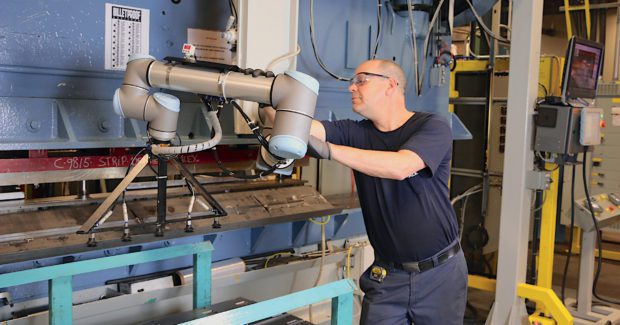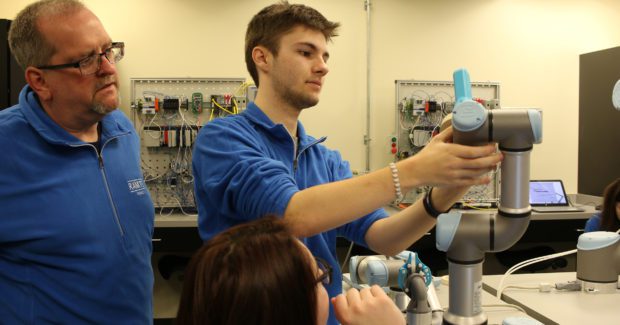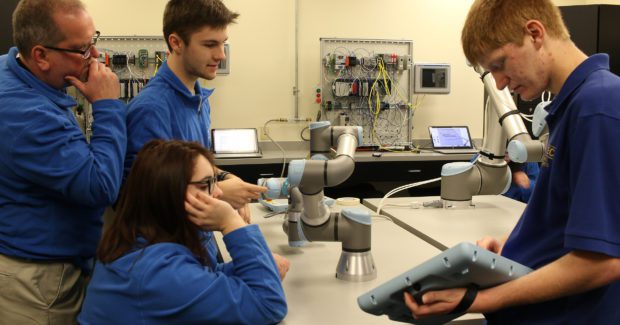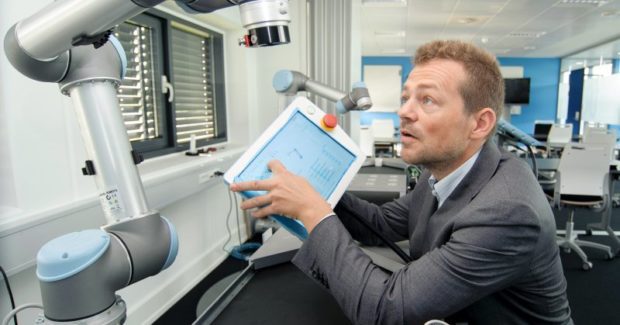Your Robot Colleague is Coming Out of Its Cage
Creating a future of automation that is not about man VS. machine, but man WITH machine.
Posted: December 21, 2016
When asked how they envision a robot, most people either think of huge, unwieldy robots working in fenced off areas in large factories. Or, they think of futuristic cyberbots mimicking human behavior. But somewhere in between these two scenarios lies a new emerging reality: a new class of robots, dubbed collaborative robots – or simply cobots – poised to bridge the gap between fully-manual assembly and fully-automated manufacturing lines. Unlike their big brothers working inside safety fencing at automobile plants and other large assembly lines, collaborative robots are lightweight, flexible and can easily be moved and reprogrammed to solve new tasks, meeting the short-run production challenge faced by companies adjusting to ever more advanced processing in smaller batch sizes. Innovative force-sensing technology enables the cobot to automatically stop operating if it encounters obstacles in its path. This means the robot can work right alongside employees, with no safety guarding after performed risk assessment.
LOWERING THE ENTRY BARRIER
According to the old rule of thumb, the cost of a robot would be equivalent to one worker’s two-year salary. But collaborative robots are closer to one-fourth of that price. With traditional robots, the capital costs for the robots themselves account for only 25 percent to 30 percent of the total system costs. The remaining costs are associated with robot programming, setup, and dedicated, shielded work cells. The “out of box experience” with a collaborative robot is typically less than an hour. That’s the time it takes to unpack the robot, mount it, and program the first simple task through an intuitive touchscreen user interface. Or, by simply grabbing the robot arm, showing it the desired path of movement.
SAFETY FIRST
Safety has been a hot-button issue and the major thrust of research and development in robotics labs for a long time. With human collaboration in mind, the new generation of industrial robots consists of rounded joints, back drivable motors, force sensors, and lighter weight materials. Features that can help solve many automation headaches in work cells unable to accommodate safety guarding or where the application requires regular human-robot interaction.
For example, consider the experience of Etalex (Anjou, QC), a Canadian manufacturer of shelving systems that had no room for fencing in front of their press brake and needed a flexible user-friendly robot able to safely handle the pick and place tasks in a high traffic area. A collaborative robot was up for the challenge. Compared to the other 25 robots in operation in their shop, all placed behind sturdy safety guarding, this cobot application is an unusual sight: a collaborative UR10 robot works right alongside employees with no fencing due to the force-sensing technology that enables the cobot to automatically stop operating if it comes into contact with employees. The lightweight UR robots at Etalex can quickly be moved and reprogrammed and are currently applied in ten different production cycles.
In the past, an Etalex employee would manually unload the press brake eight hours a day. But these tasks have now been reduced to an hour daily that is spent on inspecting the quality of each pallet and coil changing – resulting in an estimated 12 months ROI. “Previously, you had to put your hands close to the brake press. There’s always a chance of an accident happening. With this cobot, there is no chance of anyone getting injured,” explains Richard Clive, a machine operator at Etalex who stresses how the cobot has “made his workplace100 percent safer.”
NEW GUIDELINES ON RISK ASSESSMENT
There are two things to consider when designing operations for safe human-robot collaboration: the robot itself and its application. The best collaborative robot is certified by third parties to meet current cobot safety standards. In the specified application, what safety hazards are present? Because a robot is never inherently safe, a risk assessment of the entire application should always be conducted. For example, the robot may be picking up a part with sharp edges and moving it quickly at head-height. In this case, the integrator should consider what is safe if the tool or product were to hit a person. With the introduction of ISO/TS 15066, integrators now have a guideline for acceptable force for different parts of the body so they can cater the safety settings to be appropriate for the specific application. We offer configurable safety settings where the user can define the limits for force, power, speed and momentum so the robot can work safely on an application-defined basis.
SPEED VS. SAFETY
One key question should be addressed when building a robotic work cell: What is the required cycle time of the machine to get sufficient ROI? Speed and safety can often compete in an application, but it’s important to consider the benefits of removing guarding and allowing for greater operator involvement. As a machine comes closer to being 100 percent automated, the overall cost tends to rise exponentially. Certain tasks can be very challenging to automate, which adds significant cost. Those types of tasks include anything subjective, such as bin sorting or complex inspection routines. By slowing down the process so that a collaborative robot can be considered, human operators are allowed to be involved in the more challenging portions of the task, thereby reducing automation cost.
PLUG & PLAY INTEGRATION
Another cost efficient element is quick integration. While cobots themselves can be easy to use, outfitting the robot arm with the required end-effectors and accessories required to handle automation tasks can be a trial-and-error process. We have changed the way that we approach integrating third-party hardware with a robot by introducing a showroom of “Plug & Play” application solutions that offer a new level of simplicity for companies that want to hit the ground running when installing their next robot application. By choosing accessories, grippers, and software solutions from our showroom, both distributors and end-users get high security and predictability that their entire robot application will run well from the start, saving weeks and months in the integration process from concept to operation.
BRIDGING THE SKILLS GAP
Speeding up the entry of cobots into our workforce not only optimizes production here and now, it also helps to address a looming skills gap of two million unfilled manufacturing jobs that we will face in the U.S. by 2020. Attracting skilled employees is particularly difficult for the small and medium-sized shops that make up the bulk of the U.S. manufacturing base. According to the National Association of Manufacturers (Washington, DC), there are 252,000 manufacturing companies in the United States, but only 3,700 had more than 500 workers – and the vast majority of these employ fewer than 20 people. While machines can’t replace human workers in many production processes, even the smallest shops are finding collaborative robots to be an easy-to-deploy solution for this worker shortage.
But in order to bridge this gap, we must raise robot literacy. Our applications showroom, along with our new UR Academy, are both initiatives that have been launched to specifically address this. UR Academy consists of free e-learning modules that make up the basic programming training for our robots. This includes adding end-effectors, connecting I/Os and setting up safety zones. These modules are not merely a passive transfer of information. Instead, they are built to deliver hands-on learning via interactive simulations to maximize user engagement.
“We can use these robots to teach to many different skill sets because it’s like peeling an onion,” concluded a robotics teacher at RAMTEC (Robotics Advanced Manufacturing Technology Education Collaborative; Marion, OH), the largest robotics education center in the U.S. “We can bring it down and present it to fifth graders who can start programming within a few minutes. Or take it into a high school setting and have the students do more advanced motion controls. Or we can teach it in the adult classroom with many of our local manufacturers interested in having their employees up to speed on the program, so they can touch up waypoints or maybe rearrange a little bit of the logic on the fly in the production setting.”
That’s how we see the future of automation. It’s not about “man VS. machine,” but “man WITH machine.”















